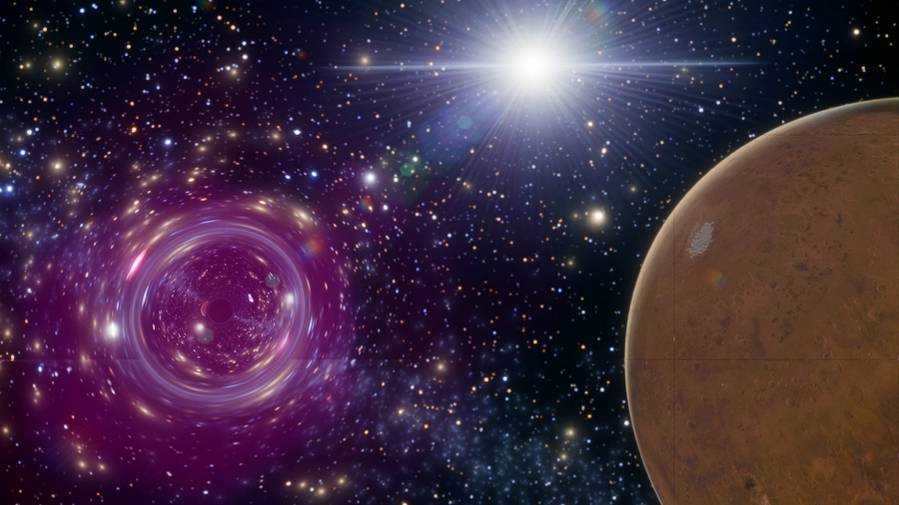Summary: MIT physicists propose that detecting subtle changes in Mars’ orbit could indicate the presence of primordial black holes, potentially solving the dark matter mystery.
Estimated reading time: 6 minutes
A team of MIT physicists has proposed a novel way to detect dark matter: by watching for wobbles in Mars’ orbit. Their study, published in Physical Review D, suggests that if dark matter consists of primordial black holes, these microscopic gravitational giants could occasionally pass through our solar system, causing detectable perturbations in planetary orbits.
The Dark Matter Dilemma
Dark matter remains one of the most perplexing mysteries in modern physics. It’s thought to make up about 80% of all matter in the universe, yet it’s invisible and undetectable through conventional means. Scientists have long searched for dark matter particles, but these efforts have come up empty-handed.
“Given decades of precision telemetry, scientists know the distance between Earth and Mars to an accuracy of about 10 centimeters,” says study author David Kaiser, professor of physics at MIT. “We’re taking advantage of this highly instrumented region of space to try and look for a small effect.”
The MIT team’s approach offers a fresh perspective on the dark matter puzzle. Instead of searching for exotic particles, they’re looking for gravitational effects that could be caused by primordial black holes – a theory first proposed in the 1970s.
Primordial Black Holes: A New Dark Matter Candidate
Primordial black holes are hypothetical objects that formed in the first moments after the Big Bang. Unlike the massive black holes that form from collapsing stars, these primordial versions could be incredibly small – as tiny as a single atom, yet as heavy as large asteroids.
The researchers calculated that if most dark matter consists of these primordial black holes, one should pass through our inner solar system about once per decade. Such a flyby could introduce a slight wobble in Mars’ orbit, shifting it by about a meter – a tiny change, but one that modern instruments could potentially detect.
Simulating Close Encounters
To test their theory, the team created a simplified simulation of the solar system, including the orbits and gravitational interactions of major planets and moons. They then modeled various scenarios of primordial black holes passing through the system.
“We extrapolated to see what would happen if a black hole flew by Earth and caused the moon to wobble by a little bit,” explains lead author Tung Tran. While effects on Earth and the moon proved difficult to isolate, Mars emerged as a promising candidate for observation.
Challenges and Future Work
The researchers acknowledge that detecting such a subtle orbital shift would be challenging. Even if a wobble is observed, confirming it was caused by a primordial black hole rather than a more mundane object like an asteroid would require further investigation.
“We need as much clarity as we can of the expected backgrounds, such as the typical speeds and distributions of boring space rocks, versus these primordial black holes,” Kaiser notes. The team is now working on more complex simulations to refine their predictions and differentiate between various scenarios.
Implications for Dark Matter Theory
If successful, this method could provide compelling evidence for the existence of primordial black holes and their role in dark matter. It represents a shift from particle-based searches to gravitational detection methods, potentially opening new avenues for dark matter research.
The study’s innovative approach demonstrates how existing technology and precise measurements of our solar system could be leveraged to probe fundamental questions about the nature of the universe.
Quiz: Test Your Knowledge
- What percentage of matter in the universe is estimated to be dark matter? a) 20% b) 50% c) 80% d) 95%
- How often does the study predict a primordial black hole might pass through our inner solar system? a) Once a year b) Once a decade c) Once a century d) Once a millennium
- By how much could a primordial black hole flyby shift Mars’ orbit, according to the study? a) 1 centimeter b) 1 meter c) 1 kilometer d) 1 million kilometers
Answers:
- c) 80%
- b) Once a decade
- b) 1 meter
For further reading:
Glossary of Terms:
- Dark Matter: Hypothetical form of matter that is thought to account for approximately 85% of the matter in the universe.
- Primordial Black Hole: Hypothetical type of black hole that formed soon after the Big Bang.
- Telemetry: The process of recording and transmitting the readings of an instrument.
- Orbital Perturbation: A deviation in an object’s orbit caused by gravitational influences.
- Ephemerides: Tables of the predicted positions of celestial bodies at regular intervals.
Enjoy this story? Get our newsletter! https://scienceblog.substack.com/
If our reporting has informed or inspired you, please consider making a donation. Every contribution, no matter the size, empowers us to continue delivering accurate, engaging, and trustworthy science and medical news. Independent journalism requires time, effort, and resources—your support ensures we can keep uncovering the stories that matter most to you.
Join us in making knowledge accessible and impactful. Thank you for standing with us!

